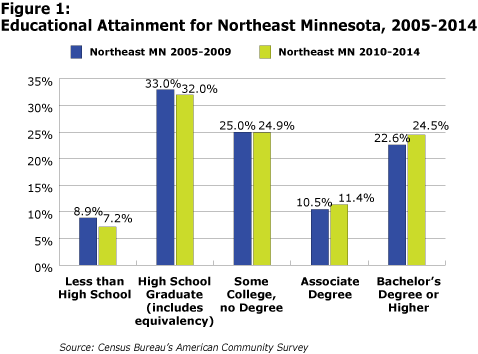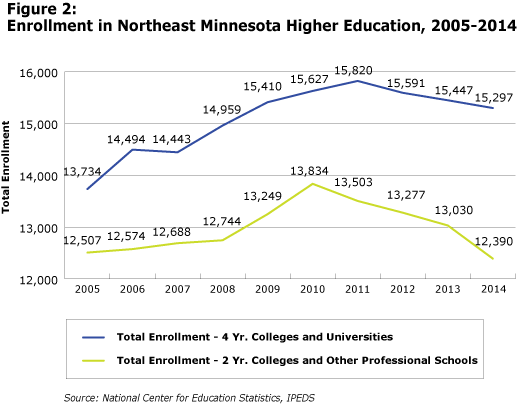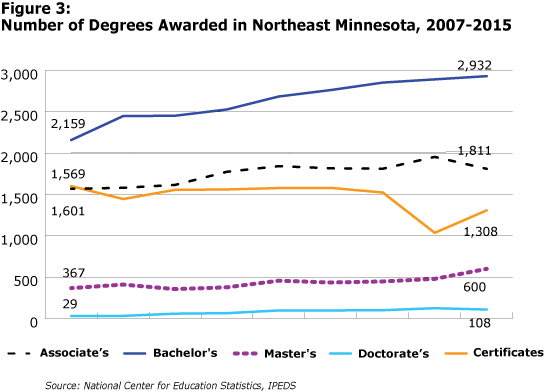by Erik White
July 2016
During the recession many people in Northeast Minnesota decided to enroll in and take advantage of the numerous higher education opportunities in the region in order to gain the knowledge, skills, and abilities that would be needed for their future careers. Data show that the number of Northlanders with less than a high school diploma decreased considerably over the past decade from 8.9 percent to 7.2 percent or 3,884 people, while residents with college degrees increased rapidly. This resulted in higher levels of educational attainment in the Arrowhead.
The release of new five-year estimates from the U.S. Census Bureau's American Community Survey for 2010 to 2014 allows non-overlapping comparisons with the five-year estimates from 2005 to 2009, showing clear changes in educational attainment for Northeast Minnesota residents during this time frame. Improvements on the lower end were impressive as the percent of the population with less than a high school degree dropped, but big changes occurred at the other end of the educational attainment spectrum as well, with the number and percent of people with college degrees increasing steadily. The 2005 to 2009 estimates showed 23,844 people in the seven-county Arrowhead region with an Associate's degree, comprising 10.5 percent of the 25 years and older population. By 2014 that had increased by 2,099 people, now constituting 11.4 percent of the adult population, notably higher than the 10.9 percent rate statewide (see Figure 1). Larger increases occurred for people earning Bachelor's, Master's, and Doctoral degrees.1 Through 2014 55,573 people in the region held a Bachelor's degree or higher, which climbed by 4,289 people since 2009, an 8.4 percent rise. While the percentage of the population 25 years and older that has a Bachelor's degree or higher in Northeast Minnesota is at an impressive 24.5 percent, it still lags the state rate of 33.2 percent.

According to the National Center for Education Statistics (NCES), Northeast Minnesota is home to diverse institutions of higher education, including the University of Minnesota-Duluth, the College of Saint Scholastica, Fond du Lac Tribal and Community College, Hibbing Community College, Itasca Community College, Lake Superior College, Mesabi Range College, Rainy River Community College, Vermillion Community College, and Duluth Business University (see Table 1).
| Table 1: Enrollment at Postsecondary Institutions in Northeast Minnesota | ||||
|---|---|---|---|---|
| 2014 Enrollment Counts | ||||
| Institution | Location(s) | Total | Full-time | Part-time |
| University of Minnesota-Duluth | Duluth | 11,093 | 9,537 | 1,556 |
| Lake Superior College | Duluth | 5,101 | 2,038 | 3,063 |
| The College of Saint Scholastica | Duluth | 4,204 | 3,305 | 899 |
| Fond du Lac Tribal and Community College | Cloquet | 2,215 | 828 | 1,387 |
| Hibbing Community College | Hibbing | 1,302 | 768 | 534 |
| Mesabi Range College | Eveleth, Virginia | 1,265 | 704 | 561 |
| Itasca Community College | Grand Rapids | 1,222 | 836 | 386 |
| Vermilion Community College | Ely | 712 | 458 | 254 |
| Rainy River Community College | International Falls | 325 | 232 | 93 |
| Duluth Business University | Duluth | 182 | 103 | 79 |
| Regency Beauty Institute-Duluth | Duluth | 46 | 46 | 0 |
| CCU College of Hair, Skin and Nails | Duluth, Hibbing | 20 | 20 | 0 |
| Source: National Center for Education Statistics, IPEDS | ||||
Enrollment trends for Northeast Minnesota Higher Education Institutions indicate that the recession of 2008 created more demand for higher education opportunities. While both four year colleges and universities and two year community colleges experienced gains in enrollment after the recession, two year community colleges in the region have seen enrollment drop recently as the economy continues to improve.
Total enrollment at four year colleges and universities in Northeast Minnesota gained by 11.4 percent since 2005, an increase of 1,563 students. Enrollment reached its high water mark in 2011 with 15,820 students, but has since declined by 3.3 percent. Likewise, 2010 was the year with the highest enrollment at two year schools in the Arrowhead region with 13,834 students. Coming out of the recession, total enrollment dropped consecutively for the next four years, a 10.4 percent decline. With 12,390 students enrolled, there are now fewer students enrolled in two year colleges and professional schools than there were in 2005 (see Figure 2).

While enrollment data can measure access to education in the region, it is also beneficial to look at the end product of the higher education experience, the awarding of the degree. At all levels of higher education, Northeast Minnesota has seen an increase in the number of degrees awarded since the recession with the exception of certificates.
The number of Associate's degrees gained in the region has increased by 242 since 2007, a 15 percent increase, while the number of Bachelor's degrees has increased by 36 percent with 773 more degrees awarded than in 2007. Larger percent increases have occurred with Master's and Doctorate's degrees as the number of Doctorate's degrees increased from 29 in 2007 to 108 in 2015, and there were 600 Master's degrees awarded in 2015, 233 more than in 2007 (see Figure 3).

DEED's Graduate Employment Outcome (GEO) data tool shows how students from the colleges and universities in Northeast Minnesota are faring in the labor market by matching postsecondary graduation records from the Minnesota Office of Higher Education with wage records from Minnesota employers subject to the state's Unemployment Insurance program. Data are available for every postsecondary institution by year, location, award type, institution type, and instructional program.
Nearly 6,000 graduates from colleges and universities in Northeast Minnesota in the 2013-2014 cohort had median wages of $18.53 an hour one year after graduation. Earnings were higher for graduates from the four year universities, but award holders from the other schools in the region earned a range from $10 to $16 an hour.
Health professions and related programs have the highest number of graduates, as the health care industry is the largest industry of employment in the region, and graduates from these programs were earning a median hourly wage of $25.32 one year after graduation. There were 1,016 graduates from the liberal arts programs at community colleges in the region, with many of these graduates going on to a four-year school to further their education. Their lower median hourly wage can be attributed to those working flexible jobs while in school. The region also had large numbers of successful graduates in business, management, marketing and related programs, education programs, and engineering technologies among others (see Table 2).
| Table 2: Graduate Employment Outcomes at Postsecondary Institutions in Northeast Minnesota by Classification of Instructional Programs Code, 2013-2014 Cohort, All Awards | ||||
|---|---|---|---|---|
| CIP Code | CIP Title | Number of
Graduates |
1 Year After Graduation | |
| Graduates With Reported Wages in Minnesota | Median
Hourly Wage |
|||
| - | Total, All CIP Codes | 5,967 | 4,389 | $18.53 |
| 51 | Health Professions and related programs | 1,351 | 1,008 | $25.32 |
| 24 | Liberal Arts and Sciences, General Studies and Humanities | 1,016 | 739 | $12.00 |
| 52 | Business, Management, Marketing, and related | 614 | 477 | $21.40 |
| 13 | Education | 422 | 315 | $21.18 |
| 14-15 | Engineers and Engineering Technologies | 355 | 252 | $23.51 |
| 47 | Mechanic and Repair Technologies/Technicians | 177 | 152 | $19.34 |
| 42 | Psychology | 173 | 137 | $14.20 |
| 3 | Natural Resources and Conservation | 126 | 81 | $19.00 |
| 43 | Homeland Security, Law Enforcement, Firefighting | 97 | 71 | $14.86 |
| 44 | Public Administration and Social Service Professions | 91 | 67 | $19.90 |
| 48 | Precision Production | 60 | 42 | $19.17 |
| 46 | Construction Trades | 35 | 29 | $16.84 |
| Source: DEED's Graduate Employment Outcomes (GEO) Program | ||||
Residents in the region turned to higher education during the recession to help gain the skills, knowledge, and abilities that would be needed in the future economy. However, data show that after increases in enrollment after the recession, the number of people entering four year colleges and universities has stabilized and those going to two year community colleges has decreased.
This indicates a changing economic landscape as the labor market tightens in the region, and employers are less restrictive in the education, training, and work experience required to fill their open positions. Going forward higher education institutions will need to continue to align their academic programs with the jobs that will be available in the future by offering the training and knowledge that is needed for these positions.